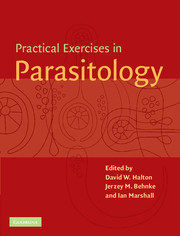Book contents
- Frontmatter
- Contents
- List of contributors
- Preface
- General advice
- 1 Observational Exercises on Parasites
- 2 Ecology
- 3 Physiology and Biochemistry
- 4 Pathology and Immunology
- 5 Chemotherapy
- 6 Molecular Parasitology
- 7 Behaviour
- 7.1 Behaviour of the miracidia of Fasciola hepatica and demonstration of other larval stages
- 7.2 Effects of age and environmental factors on the swimming behaviour of the cercariae of Cryptocotyle lingua (Trematoda)
- 7.3 Changes in host behaviour as a consequence of parasite infection
- 7.4 Behaviour of the amphipod Gammarus pulex, infected with cystacanths of acanthocephalans
- 7.5 Effects of Schistocephalus solidus (Cestoda) on stickleback feeding behaviour
- Appendix 1 Reagent index
- Appendix 2 UK suppliers
- Appendix 3 US suppliers
- Index
7.3 - Changes in host behaviour as a consequence of parasite infection
Published online by Cambridge University Press: 05 June 2012
- Frontmatter
- Contents
- List of contributors
- Preface
- General advice
- 1 Observational Exercises on Parasites
- 2 Ecology
- 3 Physiology and Biochemistry
- 4 Pathology and Immunology
- 5 Chemotherapy
- 6 Molecular Parasitology
- 7 Behaviour
- 7.1 Behaviour of the miracidia of Fasciola hepatica and demonstration of other larval stages
- 7.2 Effects of age and environmental factors on the swimming behaviour of the cercariae of Cryptocotyle lingua (Trematoda)
- 7.3 Changes in host behaviour as a consequence of parasite infection
- 7.4 Behaviour of the amphipod Gammarus pulex, infected with cystacanths of acanthocephalans
- 7.5 Effects of Schistocephalus solidus (Cestoda) on stickleback feeding behaviour
- Appendix 1 Reagent index
- Appendix 2 UK suppliers
- Appendix 3 US suppliers
- Index
Summary
Aims and objectives
This exercise is designed to demonstrate:
Parasite-induced behavioural modifications in their hosts.
Changes in behaviour at specific stages of infection.
The importance of critical evaluation of the experimental observations in terms of possible adaptive manipulation of the host.
Introduction
Many parasites with complex life cycles have adopted strategies that enhance their chances of transmission to the next host. Where no free-living stages exist, these tactics often involve a parasite-induced alteration in host behaviour that increases periods of contact with the next host. Helminths with life cycles that involve passive transfer between hosts make use of predator-prey associations (the food chain) for transmission. In many such cases, changes in host appearance or behaviour that may render them more vulnerable to predation have been described. For example, species of fresh-water shrimps infected with the cystacanth stages of acanthocephalan worms change in colour and behavioural patterns so that they are more conspicuous and spend more time in the vicinity of the precise duck, mammal or fish predator that acts as definitive host for that parasite species (see also exercise 7.5). Additional examples are reviewed by Hurd (1990).
Predation of the intermediate host will only result in successful transmission if the parasite stage is mature and infective. In some cases it has been shown that the intermediate host does not become more vulnerable to predation until the parasite has completed that stage of its development.
- Type
- Chapter
- Information
- Practical Exercises in Parasitology , pp. 415 - 422Publisher: Cambridge University PressPrint publication year: 2001



